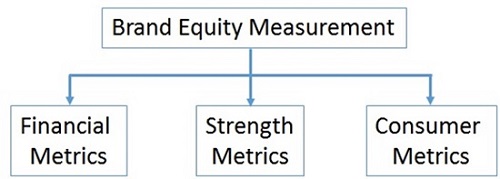
- Inside Brand Management
- Brand Management - Equity
- Brand Management - Equity Models
- Brand Management - Architecture
- Brand Identity and Positioning
- Brand Management - Promotion
- Brand Management - Extension
- Brand Management - Co-branding
- Maintaining The Brand
- Brand Management - Performance
- Brand Management - Leveraging
- Brand Management - Valuation
- Brand Management Resources
- Brand Management - Quick Guide
- Brand Management - Useful Resources
- Brand Management - Discussion
Brand Management - Valuation
Brand valuation is an interesting topic in brand management. The brand valuation is not just restricted to acquisitions and mergers but it is also important for the company management to make policies for future, to train the marketing team, to use it for information system, and provide as a reference for product or brand managers to plan their strategies.
In the entire process of brand development and management, it is essential for the brand managers to assess the progress of brand development. The companies are interested in brand audit as the owner of the organization.
What is Brand Audit?
Brand audit is an assessment of where the brand stands in the market at its present status. It is conducted by the company itself to judge the inclination of the brand. It reveals the loopholes in brand development or management process.
When is Brand Audit Conducted?
Brand audit is conducted −
When the companies are rebranding, acquiring business, or merging the businesses.
When the communication in management team and employees, or interpersonal relations among employees are unhealthy.
When brand, the strong foundation of the organization that inspires and empowers the employees is found weak.
Who Conducts Brand Audit?
The CEO of a company along with his marketing and brand management heads generally conducts brand audit. It can be an in-house team as said or an outside agency on hire.
There are two categories in which brand auditing is done −
Internal Audit
- Brand positioning
- Brand value
- Brand promise or brand essence
- Culture of the organization
- Product/service positioning
- HR policies
External Audit
- Corporate identity such as logos, and brand elements
- Collaterals such as brochures, printed material, trade fair displays
- Advertisement
- Website
- Search Engine Optimization (SEO)
- Social media
- News
- Public Relations
- Company literature such as white papers, blogs, case studies, books
- Reviews and testimonials
- Videos
- Customer service system
- Sales procedures, touch points
Brand Equity Measurement
There is little standardization and more opinions in the market about brand equity measurement. Brand equity is measured in both quantitative and qualitative brand research.
The brand equity performance can be measured by collecting data of brand performance. It includes −
- Taking face-to-face interviews with focus groups.
- Considering large sample audience to collect the data.
- By analyzing present customers as well as prospective customers.
- By conducting periodic surveys.
- Conducting experiments that examine consumers attitude and behavior.
There are three mainstay drivers or metrics of brand equity −

Financial Metrics
The company management is interested in financial aspect of brand equity to know how profitable the brand is performing in the market.
Under the financial metrics, the brand managers with marketing team should track the following −
- Cost for winning new customers
- Cost for retaining existing customers
- Growth rate
- Market share of the brand
- Marketing investments
- Price sensitivity
- Profitability
- Revenue
These are some of the many financial metrics given. By keeping the track of the trends, a brand manager can ensure that the brand is building positive equity. Also, they can use this data to explain how important the brand asset is for the company to bear brand extensions or to determine marketing budgets.
Strength Metrics
The strength metrics include measurement of the following aspects −
- Brand awareness
- Brand knowledge
- Brand loyalty
- Aided and unaided brand recall
- Buzz in the market
Consumer Metrics
It is very important for the brand managers to understand what consumers know, think, and feel about various brands. Under consumer metrics, the brand managers need to measure the following −
- Consumer sentiments
- Consumer perception
- Emotional connection with brand
- Beliefs about the brand
- Relevance of brand for the market segment
- Consumers purchasing decision and other driving factors of the brand
- Consumers opinions and feelings about the brand
- Brand associations in the consumers mind
Employer and Employee Branding
It is very difficult to find the right talent in the market. Organizations are always interested in attracting the talented employees thereby reducing the cost of grooming and training the new employees.
Employer Branding
It is the practice of creating and establishing the reputation of an organization as a place to work by associating recruitment and external HR practices with the organization as a brand. It is a way of attracting and keeping employees by −
- Good pay package
- Ethical organization culture
- Comfortable and enjoyable workplace
- Rewards, perks, appraisals, and benefits
- Excellent management performance
It forms a perception in the employees mind about what it would be like to work in the organization. It attracts not only potential employees, but also the specific ones who can fit well within the organization.

For example, the software products giant Microsoft has provided its Microsoft Careers website. Apart from featuring job opportunities, there is a blog that presents articles about how it would be to work at the company by profiling the experience of the present employees.
In addition, it provides a separate Facebook page as Women at Microsoft, to give a unique insight into the women working at the company. The YouTube video on Microsoft Career features more than 100 videos where potential employees can get to know the aspects of working with Microsoft.
Employee Branding
It is the practice of associating an employees behavior and opinions with the image, characteristics, and attributes that the organization wants to project to its external stakeholders. Here, the employee is a small version of a brand ambassador
It tries to influence the interactions among employees within the organization as well as among employees and external stakeholders. This way, an organization demonstrates its characteristics it desires to show through its employees.
Employee branding includes −
- On-job training
- Customer service or customer interaction training
- Company orientation
- Education programs associated with corporate brands
- Evaluation and reward programs
For example, Cisco Networking Academy, program under Cisco Corporate Social Responsibility, is an IT skills and career building program available to learning institutions and individuals worldwide.
CEO as a Brand Leader
A poplar CEO of a company can bring in more deal flow and generate more revenue. Brand CEO is the leader who creates a vision for the brand and leads his teams by speaking with actions more than words.
With high rank in management hierarchy and authority, a CEO can play an instrumental role in branding.
CEOs Social Media Presence
CEOs are expected to have profiles on LinkedIn, but if they have presence across every prominent social media platform, their focus on reaching consumers directly dilutes. A smart CEO finds out on which social media the target audience spends time and focuses the efforts there.
Speaking Engagements with Audience
It establishes credibility of the brand and helps to bring up CEOs reputation as an industry expert. It is an opportunity to connect to the audience in person when a CEO is physically in front of the target audience.
Author, Recognition as an Expert
Being an author of the book grants the command on the subject. Writing a book and introducing it among large audience, signing events are excellent opportunities for CEO for brand campaigns.
Awards
When a CEO gets an award as an industry expert, the credibility and reliability elevates.